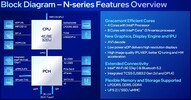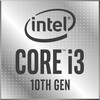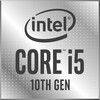Intel Processor N50 vs Intel Core i3-10110Y vs Intel Core i5-10310Y
Intel Processor N50
► remove from comparison
The Intel Processor N50 is an entry-level mobile CPU for thin and light laptops from the Alder Lake-N series. It was announced in early 2023 and offers no performance cores and 2 of the 8 efficient cores (E-cores, Gracemont architecture). The chip does not support HyperThreading and clocks with up to 3.4 GHz. The performance of the E-cores should be similar to old Skylake cores (compare to the Core i7-6700HQ). All cores can use up to 6 MB L3-cache.
Performance
The performance is clearly lower than the Processor N100 (4 cores, 3.4 GHz) due to the reduced core count. The single thread performance however, should be similar. Compared to older processors, the N50 should be comparable to dual core Skylake based CPUs like the Intel Core m3-8100Y (2x 3.4 GHz, 5W).Features
The Alder Lake-N chips only support single channel memory with up to DDR5-4800, DDR4-3200 or LPDDR5-4800. The chip also supports Quick Sync and AV1 decoding (most likely same engine as in Alder Lake). Furthermore, Wi-Fi 6E and Bluetooth 5.2 are partly integrated (but no Thunderbolt). External chips can be connected via PCIe Gen3 x9 (via the PCH).
The integrated graphics adapter is based on the Xe-architecture and offers only 16 of the 32 EUs (Execution Units) operating at only up to 750 MHz. Due to the single channel memory, low clock speeds, and low shader count, the gaming performance of the iGPU is very limited.
Power consumption
The N50 has a base power consumption of only 6 W and is therefore suited for fanless cooling. The CPU is built with a further improved 10nm SuperFin process at Intel (called Intel 7).
Intel Core i3-10110Y
► remove from comparison
The Intel Core i3-10110Y is an extremely power efficient dual-core SoC for small laptops and tablets that was announced in August 2019. The faster models, like the Core i5-10310Y offer two additional cores however.
Performance
While we have not tested a single system built around the 10110Y as of August 2023, we have tested at least one laptop utilizing the 10100Y, an insignificantly slower chip (Amber Lake, 2 cores, 4 threads, up to 3.9 GHz.) Based on that, expect the 10110Y to be noticeably faster than the AMD 3050e. Performance of this kind is totally sufficient for basic day-to-day activities, as of late 2022.
Your mileage may vary depending on how high the CPU power limits are.
The integrated graphics adapter however is still the same as in the previous generations. It should be still called Intel UHD Graphics 615 and runs at 300 - 1000 MHz in the i3. Furthermore, the SoC integrates a VP9 and H.265 de- and encoder.
The TDP is specified at 7 Watts but can be varied from 5.5 to 9 Watt from the manufacturer (cTDP up/down) resulting in different performance (especially Turbo durations). Interestingly, the faster Core i5-10210Y with two more cores can be configured to lower 4.5 Watt.
Intel Core i5-10310Y
► remove from comparison
The Intel Core i5-10310Y is a extremely power efficient quad-core SoC for small laptops and tablets based on the Comet Lake (CML-Y) generation and was announced in August 2019. Compared to the similar Amber Lake processors (e.g. Core i7-8500Y), the only difference are two additional cores in the top models (except i3-10110Y). The processor cores are clocked between 1.1 and 4.1 GHz (all 4 cores 2.8 GHz max). Thanks to HyperThreading 8 threads can be used. Compared to the faster i7-10510Y, the level 3 cache is reduced to 6 MB and the clock rates are lower.
More information on Comet Lake and all the models and articles on it can be found here.
Performance
While we have not tested a single system built around the 10310Y as of August 2023, it's realistic to expect the chip to be about half as fast as the Core i5-10210U (Comet Lake, 4 cores, 8 threads, up to 4.2 GHz) in multi-thread workloads. Those 4 cores of the 10310Y are set to be very much constrained by the low TDP target leading to high DPC latencies and generally unresponsive system behaviour no matter the activity.
The integrated graphics adapter is still the same as in the previous generations. It should be still called Intel UHD Graphics 615 and clock from 300 - 1050 MHz in the i5. Furthermore, the SoC integrates a VP9 and H.265 de- and encoder.
The chip is now produced in the 14nm++ process (Amber Lake Y was 14nm+) but not 10nm like Ice Lake Y. The TDP is specified at 7 Watts but can be varied from 5.5 to 9 Watt from the manufacturer (cTDP up/down) resulting in different performance (especially Turbo durations).
| Model | Intel Processor N50 | Intel Core i3-10110Y | Intel Core i5-10310Y | ||||||||||||||||||||||||||||||||||||||||||||||||||||||||||||||||||||||||||||||||||||||||||||||||||||
| Codename | Alder Lake-N | Amber Lake-Y | Amber Lake-Y | ||||||||||||||||||||||||||||||||||||||||||||||||||||||||||||||||||||||||||||||||||||||||||||||||||||
| Series | Intel Alder Lake-N | Intel Amber Lake | Intel Amber Lake | ||||||||||||||||||||||||||||||||||||||||||||||||||||||||||||||||||||||||||||||||||||||||||||||||||||
| Series: Amber Lake Amber Lake-Y |
|
|
| ||||||||||||||||||||||||||||||||||||||||||||||||||||||||||||||||||||||||||||||||||||||||||||||||||||
| Clock | 1000 - 3400 MHz | 1000 - 4000 MHz | 1100 - 4100 MHz | ||||||||||||||||||||||||||||||||||||||||||||||||||||||||||||||||||||||||||||||||||||||||||||||||||||
| L3 Cache | 6 MB | 4 MB | 6 MB | ||||||||||||||||||||||||||||||||||||||||||||||||||||||||||||||||||||||||||||||||||||||||||||||||||||
| Cores / Threads | 2 / 2 2 x 3.4 GHz Intel Gracemont E-Core | 2 / 4 | 4 / 8 | ||||||||||||||||||||||||||||||||||||||||||||||||||||||||||||||||||||||||||||||||||||||||||||||||||||
| TDP | 6 Watt | 7 Watt | 7 Watt | ||||||||||||||||||||||||||||||||||||||||||||||||||||||||||||||||||||||||||||||||||||||||||||||||||||
| Technology | 10 nm | 14 nm | 14 nm | ||||||||||||||||||||||||||||||||||||||||||||||||||||||||||||||||||||||||||||||||||||||||||||||||||||
| max. Temp. | 105 °C | 100 °C | 100 °C | ||||||||||||||||||||||||||||||||||||||||||||||||||||||||||||||||||||||||||||||||||||||||||||||||||||
| iGPU | Intel UHD Graphics Xe 16EUs (Tiger Lake-H) ( - 750 MHz) | Intel UHD Graphics 615 (300 - 1000 MHz) | Intel UHD Graphics 615 (300 - 1050 MHz) | ||||||||||||||||||||||||||||||||||||||||||||||||||||||||||||||||||||||||||||||||||||||||||||||||||||
| Architecture | x86 | x86 | x86 | ||||||||||||||||||||||||||||||||||||||||||||||||||||||||||||||||||||||||||||||||||||||||||||||||||||
| Announced | |||||||||||||||||||||||||||||||||||||||||||||||||||||||||||||||||||||||||||||||||||||||||||||||||||||||
| Manufacturer | ark.intel.com | ark.intel.com | ark.intel.com | ||||||||||||||||||||||||||||||||||||||||||||||||||||||||||||||||||||||||||||||||||||||||||||||||||||
| L1 Cache | 128 KB | 128 KB | |||||||||||||||||||||||||||||||||||||||||||||||||||||||||||||||||||||||||||||||||||||||||||||||||||||
| L2 Cache | 512 KB | 512 KB | |||||||||||||||||||||||||||||||||||||||||||||||||||||||||||||||||||||||||||||||||||||||||||||||||||||
| Socket | BGA1377 | BGA1377 | |||||||||||||||||||||||||||||||||||||||||||||||||||||||||||||||||||||||||||||||||||||||||||||||||||||
| Features | DDR3L-1600/LPDDR3-2133 RAM, PCIe 3, 4 GT/s bus, MMX, SSE, SSE2, SSE3, SSSE3, SSE4.1, SSE4.2, AVX, AVX2, BMI2, ABM, FMA, ADX, VMX, SMEP, SMAP, MPX, EIST, TM1, TM2, Hyper-Threading, Turbo, SST, AES-NI, RDRAND, RDSEED, SGX | DDR3L-1600/LPDDR3-2133 RAM, PCIe 3, 4 GT/s bus, vPro, MMX, SSE, SSE2, SSE3, SSSE3, SSE4.1, SSE4.2, AVX, AVX2, BMI2, ABM, FMA, ADX, VMX, SMEP, SMAP, MPX, EIST, TM1, TM2, Hyper-Threading, Turbo, SST, AES-NI, RDRAND, RDSEED, SGX |
Benchmarks
Average Benchmarks Intel Processor N50 → 0% n=0
Average Benchmarks Intel Core i3-10110Y → 0% n=0
* Smaller numbers mean a higher performance
1 This benchmark is not used for the average calculation













